
Manichaeism: The Religion that Went Extinct
Manichaeism, once a major world religion, now remains a fascinating chapter in the annals of religious history. This religion, founded in the 3rd century AD, emerged as a powerful blend of various spiritual traditions, drawing elements from Christianity, Zoroastrianism, and Buddhism. Its founder, Mani, envisioned a universal religion, transcending cultural and religious boundaries. Manichaeism's unique doctrines and practices captivated followers across the ancient world, from the Roman Empire to China.
Despite its widespread influence, Manichaeism eventually vanished, leaving behind traces of its existence through historical texts and archaeological findings. The story of Manichaeism is not just about the rise and fall of a religious movement but also a profound narrative of how religions evolve, spread, and sometimes cease to exist. Exploring the journey of Manichaeism offers insights into the complexities of religious history and the dynamics of cultural exchange in the ancient world.
In this blog post, we will embark on a journey through the life of Manichaeism, exploring its origins, beliefs, expansion, and the reasons behind its eventual extinction. We will delve into the legacy it left behind and what its story can teach us about the nature of religious movements.
Origins of Manichaeism
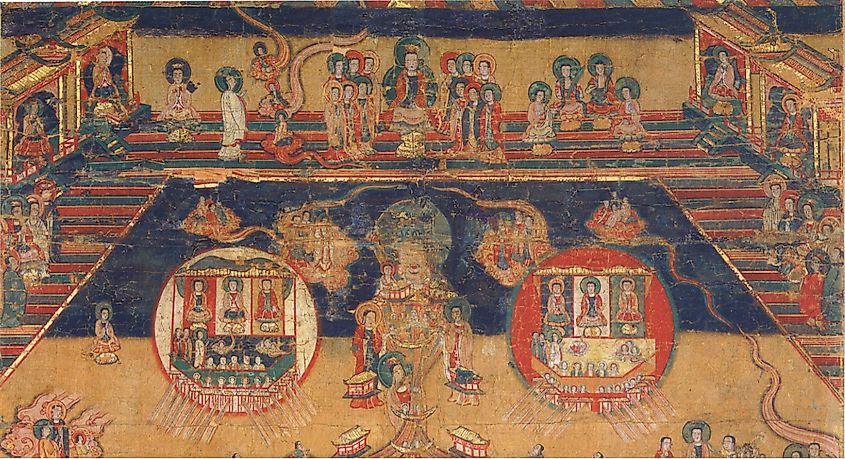
Triad of the Sun (red, Third Messenger, Mother of Life, Living Spirit), Moon (white, Light Maiden, Jesus, Primal Man), and a third divine figure (Column of Glory) between them.
Let's turn the clock back to the 3rd century AD, a period bustling with philosophical quests and religious exploration. In this vibrant era emerges Mani, an individual whose story is as colorful as the ideas he propagated. Born in 216 AD in the Parthian Empire, Mani was not just another philosopher; he was a man on a mission, blending the complex flavors of Christianity, Zoroastrianism, and Buddhism into a single, cohesive belief system.
Mani's life was anything but ordinary. He claimed to be the spiritual Paraclete promised by Jesus, positioning himself alongside prophets like Buddha and Zoroaster. This wasn't just a bold move; it was a groundbreaking approach to religious identity. Mani embarked on a journey to spread his revelations, creating a buzz across various cultures and regions.
The rapid spread of Manichaeism is a testament to its appeal and the charisma of its founder. It swiftly permeated the Persian Empire, made waves in the Roman Empire, and reached the distant lands of Central Asia. The religion's ability to resonate with diverse cultures speaks volumes about its universal appeal and the depth of its philosophical underpinnings.
One might wonder what made Manichaeism so captivating to such a broad audience. It offered a unique blend of spiritual elements, addressing the existential queries of the time. Manichaeism wasn't just a religion; it was a bridge between different cultures and philosophies, creating a mosaic of spiritual understanding.
Core Beliefs and Practices
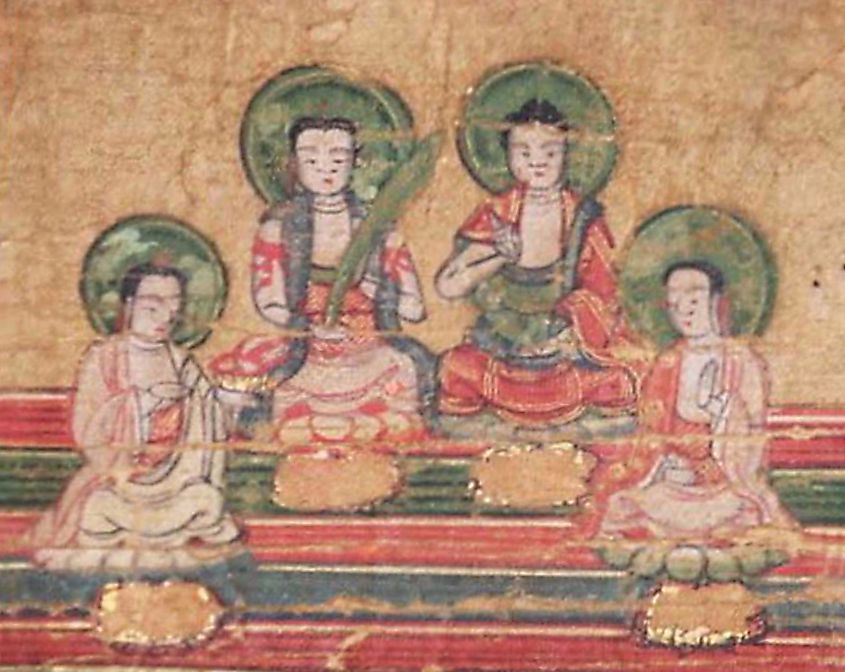
Manichaean Diagram of the Universe features Manichaeism's four primary prophets: Mani, Zoroaster, Buddha, and Jesus.
Manichaeism's core beliefs and practices, deeply embedded in a dualistic worldview, are intricately linked to a rich tapestry of cultural and religious exchanges. At its foundation was the cosmic struggle between light and darkness, a concept reflecting ancient Zoroastrian influences. This binary framework, adapted by Mani, the founder of Manichaeism, was given unique interpretations and nuances, distinguishing it from its Zoroastrian roots.
In its interaction with Christianity, Manichaeism adopted elements of Christian doctrine while reinterpreting them within its own framework. Mani regarded Jesus as a key figure in a lineage of prophets, integrating Christian ethical teachings into his teachings. This integration led to a unique Manichean conception of Jesus as a divine figure embodying light, paralleling the Christian view of Jesus as the Son of God.
The influence of Buddhism is evident in Manichaeism’s emphasis on asceticism and the pursuit of spiritual liberation, mirroring Buddhist detachment from worldly desires and the monastic lifestyle. This aspect of Manichaeism highlights its adaptability and capacity to assimilate aspects of local religious traditions.
Recent archaeological findings, particularly manuscripts such as the 9th-century Traité, the Hymnscroll, the Compendium, and Dunhuang texts, have further illuminated the adaptability and expansiveness of Manichaeism. These texts, discovered along the Silk Road and in China, showcase the synthesis of Manichean beliefs with local traditions, such as Buddhism and Taoism. They provide evidence of the two-way exchange of religious ideas, demonstrating Manichaeism's role in the broader cultural and spiritual landscape of the regions it touched.
Mani’s teachings also offered a practical guide for his followers, advocating a life of asceticism and spiritual purity. This lifestyle, characterized by strict dietary laws, frequent fasting, and moral behavior, was a cornerstone of the Manichean community, which was divided into the "Elect," following a strict ascetic lifestyle, and the "Hearers," who supported the Elect.
In summary, the core beliefs and practices of Manichaeism, enhanced by recent archaeological discoveries, reveal a religion deeply intertwined with the cultures and religious traditions it encountered. These findings underscore Manichaeism’s historical significance and its dynamic role in the religious exchanges of the ancient world.
Expansion and Influence
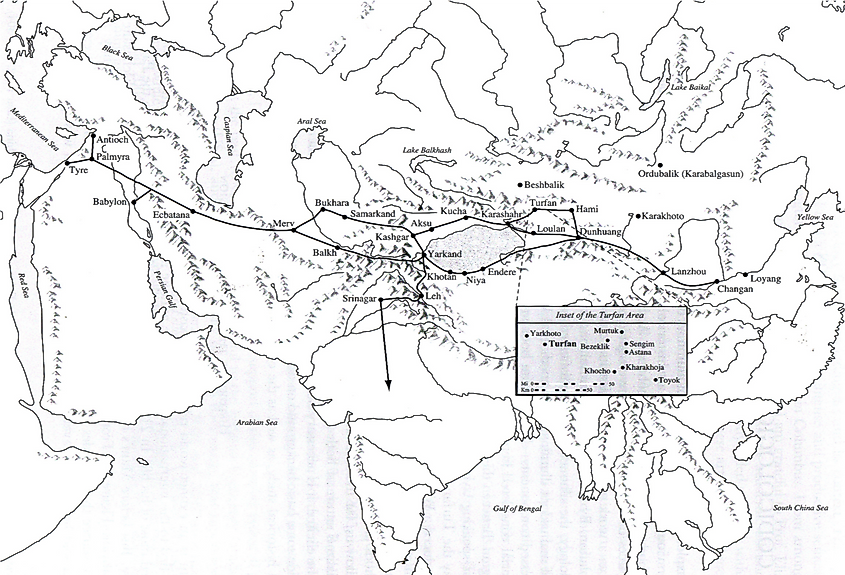
Spread of Manichaeism along the Silk Road.
Manichaeism's transformation from a regional religious movement in the 3rd century AD into a significant spiritual force demonstrates an extraordinary journey of expansion. Its rapid spread across the Roman Empire is a testament to its broad appeal. The empire's cultural and religious diversity provided a fertile environment for Manichaeism, where its dualistic nature and ethical teachings offered an alternative to traditional pagan beliefs.
The religion's fortunes in Persia were a mix of early success and subsequent challenges. Initially, it gained a considerable following, but soon, the established Zoroastrian clergy viewed it as a threat, leading to significant opposition. This resistance illustrates the volatility religious movements can face within varying political and theological landscapes.
However, it was along the Silk Road, the ancient network of trade routes, where Manichaeism's impact was particularly profound. This conduit not only facilitated the exchange of goods but also served as a path for the flow of ideas and beliefs. As Manichaeism spread along these routes, it encountered and influenced diverse cultures, particularly in Central Asia. The religion's interaction with local practices led to the integration of Buddhist and Taoist elements, exemplifying its adaptability and the dynamic nature of religious exchange.
Recent archaeological discoveries, notably the 9th-century texts such as the Traité, the Hymnscroll, the Compendium, and materials from Dunhuang, have provided invaluable insights into Manichaeism's reach and influence. These manuscripts underscore the religion's integration into various cultures, particularly in China. The blending of Manichean, Buddhist, and Taoist elements in these texts is a vivid illustration of the religion's capacity to adapt and evolve in different cultural contexts.
These findings highlight not only the extent of Manichaeism's influence but also its enduring legacy in shaping the religious and philosophical landscapes of the regions it touched, which continued to resonate in various forms within Christianity, Buddhism, and Islam, influencing spiritual and philosophical thought long after its decline.
Persecution and Decline
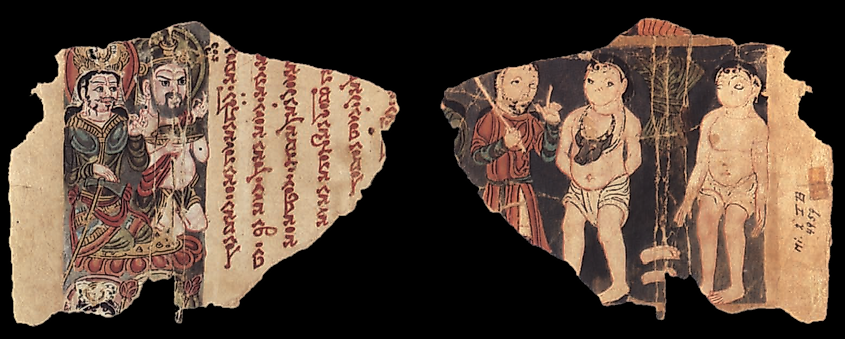
As Manichaeism navigated through different empires and cultures, it encountered not only diverse followers but also formidable challenges. The decline of Manichaeism, a once-thriving religion, was influenced by a complex tapestry of factors, most notably persecution and the shifting religious landscape of the times.
In the Roman Empire, where Manichaeism had found a significant following, the tide began to turn against it with the rise of Christianity as the state religion. Christian leaders, viewing Manichaeism as a heretical sect, initiated a series of condemnations and persecutions. This religious crackdown wasn't just a few ruffled feathers; it was a systematic effort to uproot a growing rival. Imperial edicts, such as those issued by Emperor Diocletian, led to the burning of Manichean scriptures and the persecution of its followers.
Similarly, in Persia, Manichaeism's early success soon faced obstacles. The Sassanian Empire, staunchly Zoroastrian, viewed Manichaeism as a threat to the established religious order. Zoroastrian clergy, wielding significant influence, ensured that Manichaeism was met with hostility and suppression. This persecution was more than just a disagreement over theological nuances; it was a battle for religious dominance.
The decline of Manichaeism was also accelerated by internal challenges. The religion's strict ethical codes and ascetic demands made it difficult for the broader population to fully embrace its tenets. Moreover, the hierarchical structure of the Manichean community, dividing followers into the 'Elect' and 'Hearers,' potentially limited its appeal and accessibility.
By the late Middle Ages, Manichaeism had vanished mainly from the religious map, surviving only in fragmented forms or assimilated into other belief systems. The extinction of Manichaeism serves as a poignant reminder of how religions, irrespective of their initial appeal and spread, can face existential threats from both external pressures and internal dynamics.
Manichaeism's Legacy

Though Manichaeism has faded into the annals of history, its influence persists, weaving through various aspects of religious and philosophical thought long after its decline. Its most significant contribution lies in the realm of dualistic thought, where its depiction of the universe as a battleground between light and darkness profoundly influenced theological and philosophical discourse.
In the Islamic world, particularly within the mystical traditions of Sufism, the echoes of Manichean thought are subtly present. The Sufi emphasis on the inner struggle between the lower self and the divine soul mirrors the Manichean dualism. This influence, likely transmitted through cultural exchanges along the Silk Road, points to Manichaeism’s role in shaping spiritual narratives beyond its immediate geographical boundaries.
The legacy of Manichaeism in Buddhist regions, especially evident in Central Asia, showcases its influence in the creation of syncretic religious forms. Elements of Manichean doctrine, like the focus on light as a symbol of spiritual enlightenment, were integrated into local Buddhist practices. This interaction underscores the religion's role in the cross-pollination of religious ideas and symbolism across diverse cultures.
Moreover, Manichaeism's rigorous practices and ethical teachings, emphasizing asceticism and moral purity, have parallels in medieval Christian monasticism and certain Islamic traditions. These similarities suggest an underlying influence of Manichean ethics in shaping religious conduct and spiritual discipline in other faiths.
The artistic and literary contributions of Manichaeism have also had a lasting impact. The religion’s scriptures, known for their beautiful illustrations and evocative style, offer a unique window into the spiritual and cultural life of its time. These works, uncovered in modern archaeological discoveries, have reignited academic and cultural interest in Manichaeism, providing new insights into its doctrines and practices.
Manichaeism’s journey from a dominant faith to a historical memory is a testament to the enduring nature of religious ideas and their capacity to influence far beyond their original context. Its legacy is a reminder of the rich interplay between religions and cultures, shaping and being shaped by the diverse spiritual landscapes they encounter.
Reasons for Extinction
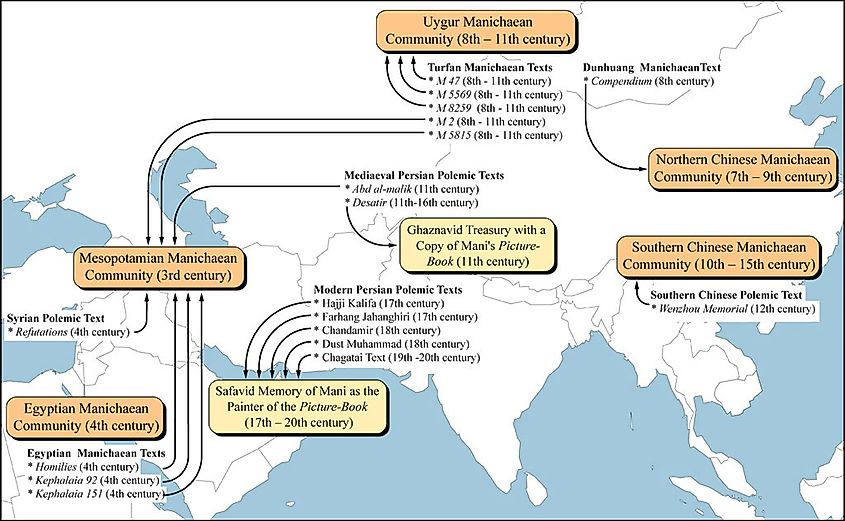
The existence of Mani's Picture-Book is documented in eighteen textual sources detailing geographical distribution and dates.
The extinction of Manichaeism can be attributed to a blend of external and internal factors. Understanding its disappearance requires delving into the myriad challenges it faced during its existence.
Externally, the most significant challenge came from persecution and political pressures. In the Roman Empire, as Christianity gained prominence and became the state religion, Manichaeism was branded heretical, leading to severe persecution. This relentless pursuit against its followers, including executions and destruction of texts, severely crippled its ability to survive and propagate. Similarly, in Persia, the Zoroastrian clergy, viewing Manichaeism as a threat, ensured its suppression under the Sassanian rule. The political and religious landscape of the time was not conducive to the survival of a new and emerging religion like Manichaeism.
Moreover, Manichaeism competed with established religions like Christianity, Zoroastrianism, and later Islam, which had deeper social roots and more robust institutional structures. By adopting and integrating similar dualistic and ethical concepts, these dominant religions diluted Manichaeism's unique appeal, leading to its gradual absorption and eventual disappearance.
Internally, Manichaeism's stringent practices and complex doctrine played a role in its decline. Its strict ethical codes and ascetic lifestyle, while appealing to a dedicated few, were too demanding for the broader population. This limited its appeal and hindered the growth of a substantial follower base.
Additionally, the hierarchical structure of Manichaeism, dividing followers into the 'Elect' and 'Hearers,' may have created a perception of exclusivity and inaccessibility. The rigorous commitment required of the Elect was a barrier too high for many, preventing the conversion and retention of a wider audience.
In contrast to more adaptive religions like Christianity and Buddhism, Manichaeism struggled to evolve in response to changing socio-political landscapes. Its inability to flexibly respond to external pressures and internal challenges ultimately led to its decline and disappearance.
The story of Manichaeism’s extinction thus serves as a powerful lesson in the history of religions. It underscores the importance of adaptability, inclusivity, and resilience in the face of external adversities and internal challenges for the survival of religious movements.
The Enduring Echoes of Manichaeism

Detail of the Manichaean Diagram of the Universe featuring the Realm of Light, with the Father of Greatness seated at the center.
Reflecting on Manichaeism’s historical journey from its rise in the 3rd century to its eventual extinction reveals a profound narrative about the life cycle of religious movements. The significance of recent archaeological discoveries in this context cannot be overstated. Manuscripts unearthed in China and along the Silk Road have provided invaluable insights into the religion’s far-reaching impact and its integration into various cultural contexts.
These findings have illuminated how Manichaeism influenced and was influenced by the regions it reached. In China, for example, Manichean texts show the religion's adaptation to Chinese culture, incorporating elements of Taoism and Buddhism. This cultural integration underscores Manichaeism’s dynamic role in the religious and philosophical exchanges of the time, highlighting its ability to transcend cultural and geographical boundaries.
Moreover, the discovery of these manuscripts along the Silk Road vividly illustrates Manichaeism's role as a bridge between East and West. Written in multiple languages, these texts reflect the religion's capacity to resonate with a diverse audience, emphasizing its significance in the history of cross-cultural religious interactions.
Manichaeism’s story, marked by its struggle to maintain its identity amidst persecution and competition, highlights the importance of adaptability in shifting political and religious landscapes. The internal complexities of Manichaeism, with its strict practices and hierarchical structure, demonstrate that the sustainability of a religion often hinges on its accessibility and relevance to a broad population. The challenges it faced in attracting and retaining a diverse follower base underscore the critical role of inclusivity and adaptability within religious movements.
In its demise, Manichaeism leaves behind a rich legacy, influencing other religious traditions and contributing to philosophical discourse, particularly on dualism. This legacy invites us to reflect on the transient nature of religious movements and the myriad factors that influence their trajectories. It also encourages a deeper appreciation of the diverse tapestry of religious beliefs that have shaped human history.
As we look back on Manichaeism’s history, we are reminded of the continuous evolution of religious thought and the changing landscape of spiritual belief systems. Its extinction, while marking a loss in religious history, offers valuable lessons and perspectives, enriching our understanding of the complex interplay between religions, cultures, and historical epochs.







